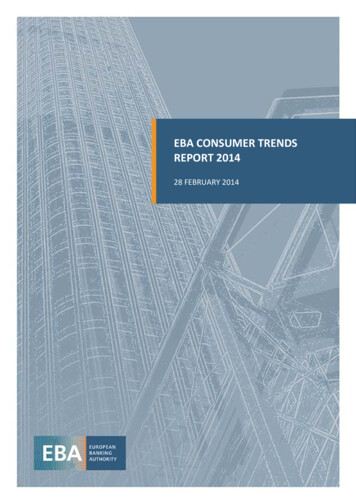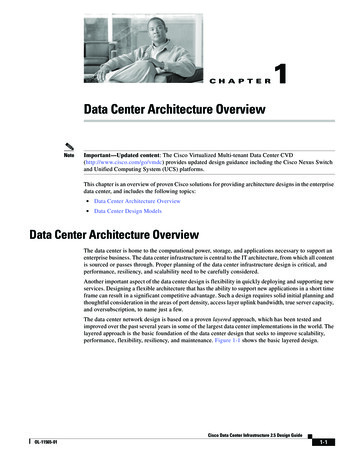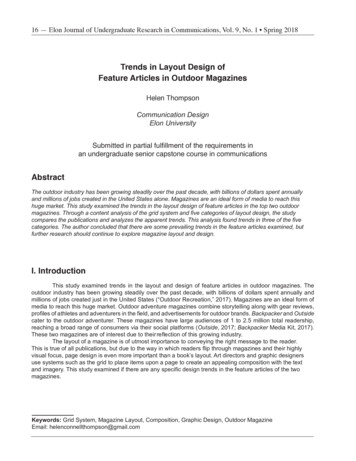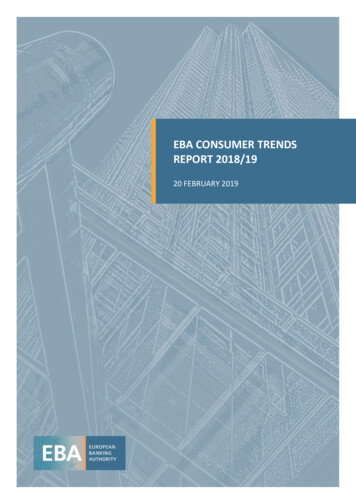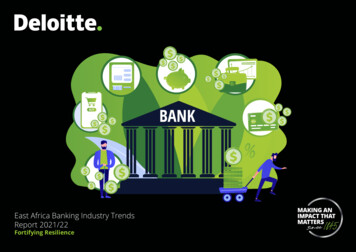
Transcription
Data Center TrendsAnd DesignSteven ShapiroCritical Facilities Practice Lead
Data Center Trends & DesignAgenda IT Trends Cooling Design Trends Power Design Trends
IT Trends VirtualizationDensityDensity vs Reliability ProfileChip Cooling
Virtualization and Density For every 18’F rise in temperature hardwarereliability decreased by 50% Footprint reduction 30% per year Since 2000, power consumption for chips doubled 17% annual increase in load density in past 10 yearsIT Trends
Chip CoolingChip Manufacturers are Investigating: New Sink Architectures Water Cooled Sinks Large Cooling Fans (up to 70 cfm per server)IT Trends
Density vs. Reliability ProfileTIERIVENTERPRISEWEB HOSTINGCOLOIIIIIOLD MAINFRAMEI50Design CriteriaIT Trends100150W/SF200250300
Total Cost of OwnershipCostDesignConfigurationReliability g RisksResilience CostsHigher ReliabilityIT TrendsEfficiency
Best Practices – Data Center Planning/Design Don’t lose the forest forthe Tiers kW/cabinet is more insightful thanaverage W/sq ft Nail the program, budget and scheduleearly on Design in modularity and scalability Optimization through planning, designand commissioningIT Trends
Cooling Design TrendsFighting Density and IncreasingEnergy Efficiency In the Data Center For the Data Center System Selection Process Economization Alternatives
In The Data CenterFan Powered Cabinet ExampleCabinet FansHot Air PlenumRaisedFloorHot Airis discharged out ofthe top via ductworkCooling TrendsConditioned Airis drawn through thefront of the cabinet
In The Data CenterWater Cooled Cabinet ExampleCabinet FansDischarge AirCooling CoilSupply ReturnPipingHigh Pressureflex hose and quick-connectfittings to chilled water mainsCooling TrendsRaisedFloorFan Coilon rear doorcools serversConditioned Airis drawn through thefront of the cabinet
In The Data CenterHot Aisle Cold Aisle ConfigurationReturn AirColdAisleHotAisleConditioned Airis drawn through thefront of the cabinetCooling TrendsColdAisleHot Airis discharged out of theback of the cabinetConditioned Airis drawn through thefront of the cabinet
For The Data CenterSystem Alternatives Chiller/Cooling Tower Air Cooled Chiller Adiabatic Cooling/Swamp Cooler(Roof, Ground, CRAH) Outside Air Air to Air (Munthers, Schneider, HuntAire, Kyoto) Water Side Economizer (Heat Exchanger) DX Backup/Full-Partial DrycoolersCooling Trends
For The Data CenterSystem Selection ProcessCooling Trends
For The Data CenterSystem Selection ProcessCooling Trends
For The Data CenterSystem AlternativesDirect Air Economizer SystemOutside air doesenter the data centerCooling TrendsIndirect Air Economizer SystemOutside air does not enterthe data center
For The Data CenterSystem AlternativesDirect Evaporative Air Economizer“Swamp” cooler with outside airentering the data centerCooling TrendsIndirect Evaporative Air Economizer“Swamp” cooler without outsideair entering the data center
For The Data CenterSystem AlternativesKYOTO WHEELIndirect Air-side EconomizerCooling Trends
Power Design Trends Reliability / AvailabilityUPS TechnologyConcurrent MaintainabilityExample One Line
Reliability / Availability Load Density (The Major Issue) 99.9999% Availability (“Six Sigma”) 2(N 1), 2N, N 2 Redundancy Common N or (N 1) Systems Not Good Enough Full Concurrent Maintenance Fault Tolerant Configurations – Eliminate SPOF’sPower Design Trends
UPS Technology UPS with transformer or transformer free Efficiency Ground current issues UPS Modules with internal redundancy Internal redundancy but same single input/output UPS System Static Switch module level system level UPS Technology Double ConversionOfflineLine interactiveDelta ConversionRotaryetc.Power Design Trends
UPS Technology Eco Mode Good - Efficiency Bad – UPS Offline ITIC Curve/CBEMA Curve UPS Distribution Voltage 600, 575, 480V, 415V,120/208V 3 Phase 3 Wire,3 Phase 4 Wire DC systems andvoltage – 380VDCPower Design Trends
UPS TechnologyTypical UPS Configurations Single Module Systems Isolated Redundant Parallel Redundant Distributed Redundant Block RedundantPower Design Trends
Reliability / AvailabilityParallelRedundantPower Design Trends
Reliability / AvailabilityDistributedRedundantPower Design Trends
Reliability / AvailabilityBlock RedundantPower Design Trends
Cost, Availability and Design TopologyPushing the Limits of Complexity Bad Capital InvestmentPower Design Trends
Data Center Electrical InfrastructureTopologies – Reliability TableDescription of RBDMTBF(Hours)Inherent Availability(Ai)Probability ofFailure in 5 yearsN 1 UPS system - dual cord loads32,5090.9998162658.16%Distributed Redundant (2-3) UPS system - dual cordloads161,6460.999979947.43%2N UPS system - dual cord loads214,1820.999987236.56%2(N 1) UPS system - dual cord loads305,2510.99998686.49%Utility and N 1 UPS system, ASTSs - dual cordloads65,0560.999998218.02%Redundant Reserve (2-3) UPS System, ASTSs dual cord loads257,4590.999990582.58%Distributed Redundant (2-3) UPS system, ASTSs dual cord loads256,6740.999990462.72%2N UPS system, ASTSs - dual cord loads445,6910.999998451.12%2(N 1) UPS system, ASTSs - dual cord loads989,9600.999998390.88%Power Design Trends
Electrical Trends575V DistributionTraditional voltage distribution to the PDU primary is 480V,consider use of 575VBenefits: Reduces cable and bus sizes by 20% Allows systems to operate more efficiently Allows more capacity out of the equivalent 480Vinfrastructure Maintains the use of standard equipment sizes Can be utilized with UPS, motor and all other majorequipment within the building Overall reduces initial installation cost and long termmaintenance and operating costsPower Design Trends
Electrical Trends415V Distribution and Eliminate Transformers Transformers are traditionally used to step down the voltage to 208Vfor use at the server rack. Because the vast majority of modern servers are designed for theglobal market including the IEC low voltage standard 415/240V, theimplementation of a 415/240V UPS system with a 3 phase, four wiredistribution can be used. Distribution at 415/240V eliminates the transformation requirementsand aligns critical loads directly with the UPSBenefits: Still maintains the use of standard equipment, electrically and servers Reduces one level of transformation, increasing overall electricalefficiency by 2%. Reduces HVAC requirements by 6 tons/MW. Reduces the amount of equipment needed to support the load,reducing initial costs. Increases reliability and availability, and reduces maintenance costsPower Design Trends
Electrical Trends – Eco ModePower Design Trends
Concurrent MaintainabilityGoals “Change Tires, Transmission and Engine at60mph and Don’t Lose Speed.” No IT Downtime for Preventative andCorrective Maintenance ScalabilityPower Design Trends
Concurrent MaintainabilityThe Solution Dual/Diverse Utility Services Dual Active Distribution Paths N 2 Generator Plant “Self-Healing” Automation and Control Physical Separation/Compartmentalization 2N Static UPS or Similar Dual Electrical Cords to IT CabinetsPower Design Trends
Medium Voltage DistributionUtility Bypass/Gen Control MaintenanceRed-Normal ‘A’Green-Normal ‘B’Yellow-GeneratorPower Design Trends
UPS – Normal OperationRed-Normal ‘A’Green-Normal ‘B’Blue-UPS ‘A’Pink-UPS’B’Power Design Trends
UPS to RPP Normal OperationBlue-UPS ‘A’Pink-UPS’B’Power Design Trends
QUESTIONS?Steven Shapiro, /stevenshapiropeThank you and please feelfree to contact me
Data Center Trends And Design. Data Center Trends & Design Agenda IT Trends Cooling Design Trends Power Design Trends. IT Trends Virtualization . increasing overall electrical efficiency by 2%. Reduces HVAC requirements by 6 tons/MW. Reduces the amount of equipment needed to support the load,

